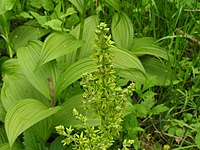- Image via Wikipedia
Botanical Name:Veratrum viride Ait
Family: Melanthiaceae
Kingdom: Plantae
Order: Liliales
Genus: Veratrum
Species: V. viride
Other common names.—True veratrum, green veratrum American veratrum green hellebore, swamp hellebore, big hellebore, false hellebore, bear corn, bugbane, bugwort, devil’s-bite, earth gall, Indian poke, itchweed, tickleweed, duck-retter.
Indian Poke, Indian Hellebore, False Hellebore, Green False Hellebore)
Part used.—The rootstock, dug in autumn when the leaves have died down.
Habitat and range.—American false-hellebore is native in rich wet woods, swamps and wet meadows, its range extending from Canada, Alaska, and Minnesota south to Georgia and Tennessee.
In eastern North America, var. viride occurs from southwestern Labrador and southern Quebec south to northern Georgia. In the west, var. eschscholzianum occurs from Alaska and Northwest Territory south through Yukon, British Columbia, Alberta, Washington, Idaho, Montana, and Oregon to northern California.
It is found in wet soils in meadows, sunny streambanks, and open forests, from sea level in the north of the range, up to 1,600 m in the southeast and 2,500 m in the southwest
Description.—The large bright-green leaves of this plant make their way through the ground early in spring, followed later in the season by a stout, erect leafy stem, sometimes growing as tall as 6 feet. It is round and solid, pale green, closely surrounded by the sheathing bases of the leaves and unbranched except in the flowering head. The large leaves, the lower ones of which are from 6 to 12 inches in length and 3 to 6 inches in width, are hairy and pleated like a fan. The numerous greenish-yellow flowers are produced from May to July in rather open clusters. The plant is very poisonous……...CLICK & SEE THE PICTURES
It is extremely toxic, and is considered a pest plant by farmers with livestock. The species has acquired a large number of common names within its native range, including American False Hellebore, American White Hellebore, Bear Corn, Big Hellebore, Corn Lily, Devils Bite, Duck Retten, Indian Hellebore, Itch-weed, Itchweed, Poor Annie, Blue Hellebore, and Tickleweed.
It is a herbaceous perennial plant reaching 0.7–2 m tall, with a solid green stem. The leaves are spirally arranged, 10–35 cm long and 5–20 cm broad, elliptic to broad lanceolate ending in a short point, heavily ribbed and hairy on the underside. The flowers are numerous, produced in a large branched inflorescence 30–70 cm tall; each flower is 5–12 mm long, with six green to yellow-green tepals. The fruit is a capsule 1.5–3 cm long, which splits into three sections at maturity to release the numerous flat 8–10 mm diameter seeds. The plant reproduces through rhizome growth as well as seeds.
There are two varieties:
Veratrum viride var. viride. Eastern North America. Side branches of inflorescence erect or spreading.
Veratrum viride var. eschscholzianum (Roemer & Schultes) Breitung. Western North America. Side branches of inflorescence drooping.
The related western North American Veratrum californicum (White False Hellebore, Corn Lily) can be distinguished from sympatric var. eschscholzianum by its whiter flowers, with erect side branches of the inflorescence
Medicinal uses:
The plant is highly toxic, causing nausea and vomiting. If the poison is not evacuated, cold sweat and vertigo appears. Respiration slows, cardiac rhythm and blood pressure falls, eventually leading to death.
It is used externally by several Native American nations. Although is rarely ever used in modern herbalism due to its concentration of various alkaloids, it has been used in the past against high blood pressure and rapid heartbeat; a standardized extract of V. viride alkaloids known as alkavervir was used in the 1950s and 1960s as an antihypertensive. The root contains even higher concentrations than the aerial parts.
Any use of this plant, especially internal use, should be carried out with great care and preferably only under the supervision of a qualified practitioner. A decoction of the root has been used in the treatment of venereal disease. The roots have been grated then chewed and the juice swallowed as a treatment for colds. A poultice of the mashed raw root has been used as a treatment for rheumatism, boils, sores, cuts, swellings and burns. The dried and ground up root has been used as a dressing on bruises and sores. A poultice of the chewed root has been applied to rattlesnake bites to draw out the poison. The powdered root has been rubbed on the face to allay the pain of toothache. A decoction of the root has been taken orally by both men and women as a contraceptive. A dose of one teaspoon of this decoction three times a day for three weeks is said to ensure permanent sterility in women.
The plant was used by some tribes to elect a new leader. All the candidates would eat the root, and the last to start vomiting would become the new leader.
Disclaimer:The information presented herein is intended for educational purposes only. Individual results may vary, and before using any supplements, it is always advisable to consult with your own health care provider.
Resources:
http://www.hort.purdue.edu/newcrop/herbhunters/falsehellebore.html
http://en.wikipedia.org/wiki/Veratrum_viride
http://www.herbnet.com/Herb%20Uses_C.htm
Related articles
- February GBBD: New Hellebores for 2012 (carolynsshadegardens.com)
- Winter Interest Plants (carolynsshadegardens.com)
- Hella-What?????? (thegardendiaries.wordpress.com)
- ANN LOVEJOY | Handsome, hardy winter perennials (kitsapsun.com)
- Cutting Back Hellebores (carolynsshadegardens.com)
- January GBBD: Hellebores on Parade (carolynsshadegardens.com)
- Hellebores bring color to shaded areas (sfgate.com)
- Alphabe Thursday: H for Hebe, Hellebore and Heather (hurtlingtowards60.wordpress.com)
- New varieties of Hellebores will brighten the garden (seattletimes.nwsource.com)
- Deep purple: There are hellebores – and then there are Rodney Davey’s hellebores (independent.co.uk)





































